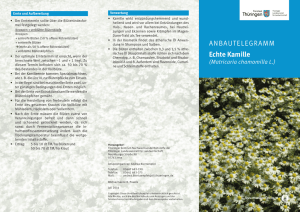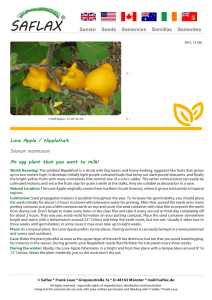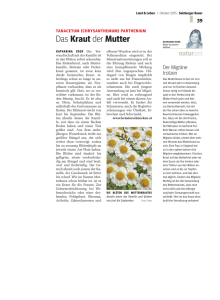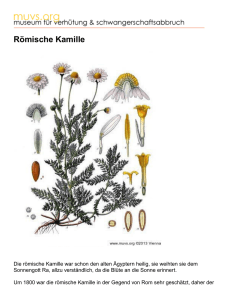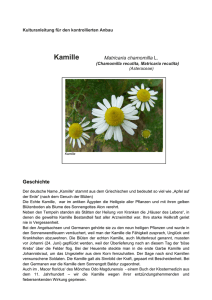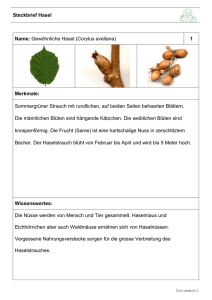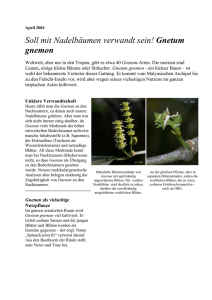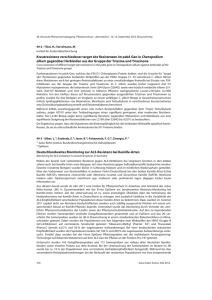Samen Seeds Semences Semillas Sementes
Werbung
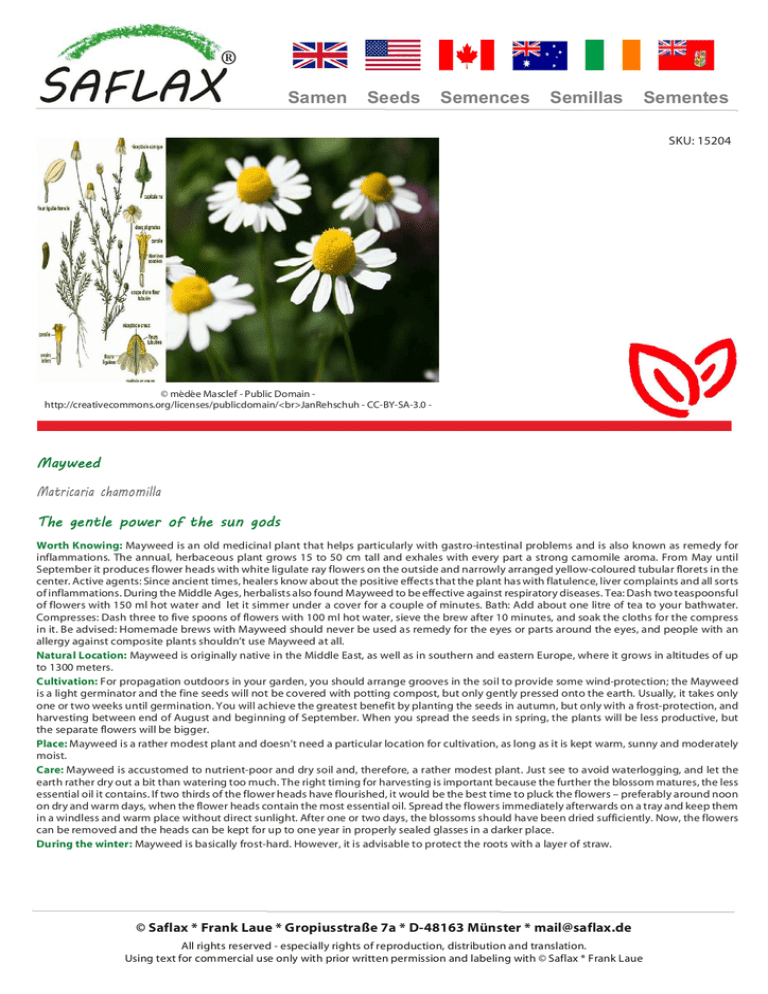
® Samen Seeds Semences Semillas Sementes SKU: 15204 © médée Masclef - Public Domain http://creativecommons.org/licenses/publicdomain/<br>JanRehschuh - CC-BY-SA-3.0 - Mayweed Matricaria chamomilla The gentle power of the sun gods Worth Knowing: Mayweed is an old medicinal plant that helps particularly with gastro-intestinal problems and is also known as remedy for inflammations. The annual, herbaceous plant grows 15 to 50 cm tall and exhales with every part a strong camomile aroma. From May until September it produces flower heads with white ligulate ray flowers on the outside and narrowly arranged yellow-coloured tubular florets in the center. Active agents: Since ancient times, healers know about the positive effects that the plant has with flatulence, liver complaints and all sorts of inflammations. During the Middle Ages, herbalists also found Mayweed to be effective against respiratory diseases. Tea: Dash two teaspoonsful of flowers with 150 ml hot water and let it simmer under a cover for a couple of minutes. Bath: Add about one litre of tea to your bathwater. Compresses: Dash three to five spoons of flowers with 100 ml hot water, sieve the brew after 10 minutes, and soak the cloths for the compress in it. Be advised: Homemade brews with Mayweed should never be used as remedy for the eyes or parts around the eyes, and people with an allergy against composite plants shouldn’t use Mayweed at all. Natural Location: Mayweed is originally native in the Middle East, as well as in southern and eastern Europe, where it grows in altitudes of up to 1300 meters. Cultivation: For propagation outdoors in your garden, you should arrange grooves in the soil to provide some wind-protection; the Mayweed is a light germinator and the fine seeds will not be covered with potting compost, but only gently pressed onto the earth. Usually, it takes only one or two weeks until germination. You will achieve the greatest benefit by planting the seeds in autumn, but only with a frost-protection, and harvesting between end of August and beginning of September. When you spread the seeds in spring, the plants will be less productive, but the separate flowers will be bigger. Place: Mayweed is a rather modest plant and doesn’t need a particular location for cultivation, as long as it is kept warm, sunny and moderately moist. Care: Mayweed is accustomed to nutrient-poor and dry soil and, therefore, a rather modest plant. Just see to avoid waterlogging, and let the earth rather dry out a bit than watering too much. The right timing for harvesting is important because the further the blossom matures, the less essential oil it contains. If two thirds of the flower heads have flourished, it would be the best time to pluck the flowers – preferably around noon on dry and warm days, when the flower heads contain the most essential oil. Spread the flowers immediately afterwards on a tray and keep them in a windless and warm place without direct sunlight. After one or two days, the blossoms should have been dried sufficiently. Now, the flowers can be removed and the heads can be kept for up to one year in properly sealed glasses in a darker place. During the winter: Mayweed is basically frost-hard. However, it is advisable to protect the roots with a layer of straw. © Saflax * Frank Laue * Gropiusstraße 7a * D-48163 Münster * [email protected] All rights reserved - especially rights of reproduction, distribution and translation. Using text for commercial use only with prior written permission and labeling with © Saflax * Frank Laue ® Samen Seeds Semences Semillas Sementes Artikel-Nr: 15204 © médée Masclef - Public Domain http://creativecommons.org/licenses/publicdomain/<br>JanRehschuh - CC-BY-SA-3.0 - Echte Kamille Matricaria chamomilla Milde Kraft der Sonnengötter Wissenswertes: Die Echte Kamille ist eine alte Heilpflanze, die vor allem bei Magen- und Darmbeschwerden sowie bei Entzündungen Verwendung findet. Die einjährige krautige Pflanze erreicht Wuchshöhen von 15 bis 50 Zentimetern und alle Pflanzenteile verströmen einen starken Kamillengeruch. Von Mai bis September zeigen ihre Blütenköpfchen außen weiße Zungenblüten und in der Mitte ihre dicht gedrängten gelben Röhrenblüten. Wirkende Kräfte: Seit der Antike wussten die Heilkundigen auch um die gesundheitlichen Wirkungen bei Blähungen, Leberleiden und Entzündungen aller Art und im Mittelalter entdeckten Kräuterkundige zudem ihre Wirkung bei Atemwegskrankheiten. Tee: übergießen Sie zwei Teelöffel Blüten mit 150 ml heißem Wasser und lassen den Tee für einige Minuten abgedeckt ziehen. Bad: Fügen Sie einen Liter Tee dem Badewasser zu. Umschläge: Drei bis 5 Löffel Blüten mit 100 ml heißem Wasser übergießen. Nach 10 Minuten abseihen und die Umschläge darin einweichen. Bitte beachten Sie: Selbst hergestellte Zubereitungen aus Kamillenblüten sollten Sie keinesfalls am oder im Auge anwenden und Menschen, die auf Korbblütler allergisch reagieren, sollten Kamille nicht benutzen. Naturstandort: Die ursprüngliche Heimat der Echten Kamille liegt in Vorderasien sowie in Süd- und Osteuropa. wo sie bis in Höhenlagen von 1300 Metern zu finden ist. Anzucht: Im Garten nehmen Sie die Anzucht am besten in vorbereiteten Rillen vor, um die Windverdriftung zu verhindern, denn als Lichtkeimer sollte das feine Saatgut nicht mit Erde bedeckt, sondern nur angedrückt werden. Die Keimung erfolgt gewöhnlich nach ein bis zwei Wochen. Den höchsten Ertrag erreichen Sie bei Aussaat im Herbst (dann aber mit Winterschutz) und einer „Ernte“ Ende August bis Anfang September. Bei einer Frühjahrssaat sind die Erträge niedriger; dafür sind die Einzelblüten größer. Standort: Die Kamille stellt keine hohen Ansprüche an ihren Standort, solange er warm, sonnig und mäßig feucht ist. Pflege: Kamille ist nährstoffarme und trockene Böden gewohnt und daher anspruchslos. Vermeiden Sie aber Staunässe und lassen Sie die Erde eher trocken fallen. Der richtige Erntezeitpunkt ist wichtig, denn je weiter die Blüte fortschreitet, desto geringer ist der Gehalt an ätherischen Ölen. Wenn zwei Drittel der Blüten am Köpfchen aufgeblüht sind, ist die beste Zeit zum Pflücken - optimal mittags an trockenen und warmen Tagen, wenn sich die Köpfchen voll öffnen und das meiste ätherische Öl enthalten. Verteilen Sie die Blüten direkt nach dem Pflücken auf einem Tablett und stellen es an einen windstillen und warmen Platz ohne direkte Sonne. Nach ein bis zwei Tagen sollten die Blüten dann ausreichend getrocknet sein. Jetzt können Sie die Blüten entfernen und die Köpfchen in dicht schließenden Gläsern bis zu einem Jahr dunkel lagern. Im Winter: Die Echte Kamille ist eigentlich winterhart Trotzdem empfiehlt es sich die Basis mit einer Strohschicht zu bedecken. © Saflax * Frank Laue * Gropiusstraße 7a * D-48163 Münster * [email protected] Alle Rechte, insbesondere das Recht der Vervielfältigung und Verbreitung sowie der Übersetzung, vorbehalten. Verwendung der Texte zum gewerblichen Gebrauch nur nach schriftlicher Zustimmung und unter Kennzeichnung durch den Zusatz © Saflax * Frank Laue

